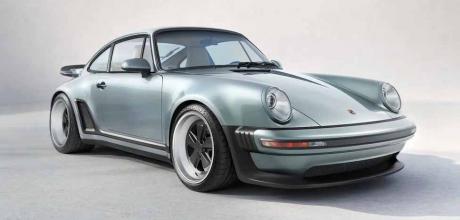Singer Porsche 911 Turbo Study
Turbo Study. Total 911 takes a first look at Singer’sthird act: a 964-based homage tothe legendary 930 Turbo “Everything’s been touched, but at the same time it has to feel sincere to the original 930”
Rob Dickinson, founder of the California-based Singer Vehicle Design, still remembers his first ride in a Porsche 911, as a wide-eyed 11-year-old back in 1976. “It was a black 930 Turbo with red tartan seats which left me dry-mouthed and speechless,” he says of Porsche’s first ever turbocharged road car, which at that point was only a year old. Goodness knows what the young Rob would make of the Turbo Study that his older self has just unleashed on the world. Rather incredibly, this is the first time he’s worked Singer’s magic on a road-going turbocharged 911 (the turbocharged ACS is for offroad competition), and its ‘third act’ following the Classic series and DLS models. “The DLS project took the normally aspirated air-cooled engine to its natural apogee, and now I think the time is right to move to the other aspect that’s synonymous with Porsche, the turbo engine, and celebrate arguably the most important 911 in Porsche’s heritage,” says Rob. “It’s a car that was incredibly meaningful for me as a child. For many it was the pin-up of the era, and this also represents a chance to really focus on an iconic model [the ‘Classic’ focuses on an era] and pour as much love on to it as possible. We’ve had a lot of interest from clients for a number of years and we’ve been working on this project for two years… it’s very exciting.”
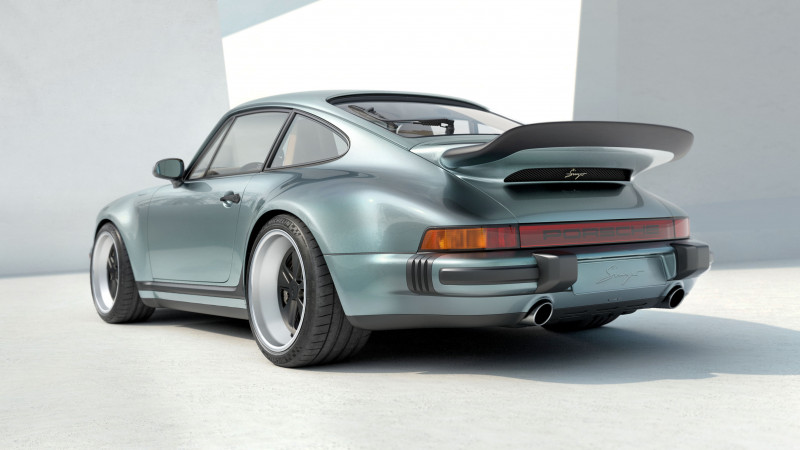
Taking that seminal 930 Turbo as inspiration, the Turbo Study subjects the period 911 to Singer’s painstaking attention to detail that always seems undersold by the rather slapdash-sounding ‘restomod’ tag, and stretches the Singer formula towards roadfocused GT comfort. “Our study very much presents the Turbo in the way Porsche did in 1975: as a super-refined, luxury, top-of-the-range, grand-touring supercar,” explains Rob. “This is our vision of the 930 Turbo, but turned up to 11.” Like the original, the Turbo Study features a turbocharged, air-cooled flat six, manual gearbox and rear-wheel-drive layout. Iconic details including a whaletail rear spoiler, full-width rear light bar, Fuchs alloys, shark fin rear-wheel arch spats and engorged rear track are all present and correct, but the muscle is exaggerated, the detail crisper. It’s like twisting a camera’s focus ring to make every nuance pin-sharp. Yet like everything Singer works its magic on, what appears to be a relatively simple if beautifully executed concept on the surface becomes more complex the deeper you dig. As Rob puts it, “Everything’s been touched, but at the same time it has to feel sincere to the original 930.” This isn’t, for instance, a 1975-1989 Porsche 930 Turbo. Instead, the Turbo Study sticks with Singer’s preferred and later 964 foundations. The logic is that these successor models, produced from 1989 to 1994, were the last to retain the classic 911 shape. They still feature the air-cooled flat six and trailing arm rear suspension, but are an altogether more modern proposition courtesy of coil-sprung suspension, power steering, ABS and optional all-wheel drive (an option not ticked by this particular owner, if offered by Singer to its clients since 2014).
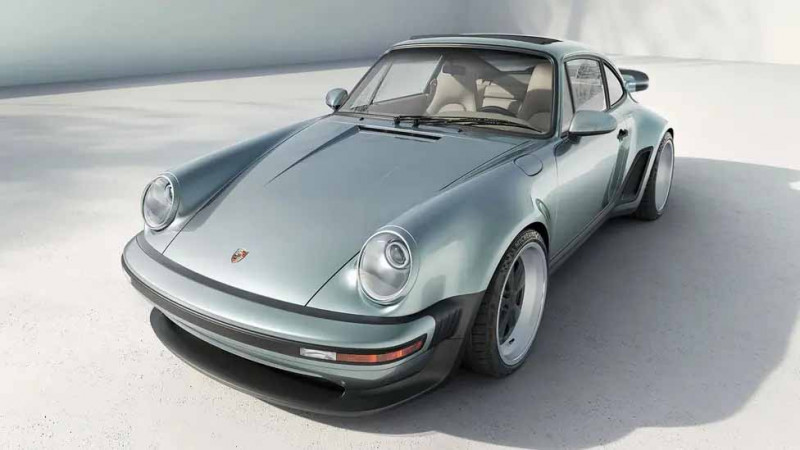
And Singer, of course, has already invested heavily in bringing the 964 formula up to date. It’s understandable (and fitting given Porsche’s preference for doing the same) that the company should build on its 12 years of expertise from its HQ in the city of Torrance. Before his seminal passenger ride, by coincidence British-born Rob spotted a 911 Turbo parked outside a pub in his native Norwich, this time finished in white. The aesthetics stopped him in his tracks. “It was fascinating to me how the 911 had become this lantern-jawed, extended rubbery thing with impact bumpers, where before it was a slender-hipped, chrome-draped, delicate little thing. I was struckby how gratuitously pornographic it was, the sheer audacity of it. For 11-year-old me, Porsche became synonymous with beautifully moulded black rubber.” Finished in icy Wolf blue paint, Singer’s vision of the 930 Turbo is even more X-rated. An original 964 body is first fully stripped, media-blasted, rustproofed and strengthened with additional welding, before lightweight carbon fibre panels are added: including the front and rear wings, bonnet, engine lid and – if there’s no sunroof – the roof itself. At around 1,270kg, the Turbo Study is about 30kg lighter than a 3.3-litre original, if fitted with far larger wheels, extra luxuries and optimised thermal management – in part explaining why the weight saving isn’t greater. Then there are the details again, including – yes – even the strangely alluring rubber with its striking 3D definition, which works wonderfully with the satinblack wheel centres and Michelin rubber stretched over the barrels of the wheels. Frankly, it’s Bo Derek in scuba gear. The piercing headlights are obviously modern reinterpretations of the original, but so too are the tail lights and full-width rear light bar, despite a factory appearance. Fuchs-style wheels shod with Michelin Pilot Sport 4S or Cup 2 tyres step up from Singer’s regulation 17 inchers to 18s shared with the DLS, with the dish on the rears like a giant hamster wheel.
“You could argue the bodywork of the 930, the wheel arches in particular, made promises the wheels couldn’t keep,” says Rob. “We’ve tried to fix that.” The 18s, in turn, enable Singer to run larger brakes – in this case Brembo calipers gripping cross-drilled carbon-ceramic discs. Even before you open the engine lid, the rear bodywork provides clues as to how the Turbo Study’s forced-induction loop is cooled. Take the rear wing, for instance. It’s honed in deference to the 3.0-litre original’s with its strong horizontal line that culminates in an upswept flourish. It’s unlike the later 3.3 that sandwiched a box between the wing and engine lid to package a large intercooler, yet looked like a chest freezer. “We were eager to present an early whaletail rear spoiler, because it’s one of the most gorgeous pieces of sculpture,” says Rob. Look carefully at the rear shark fin graphic and you’ll notice that while it faithfully echoes the original – intended simply to prevent stone chips striking the vulnerable rear arches – it also incorporates a large air vent to feed cooling air to the engine’s induction. Rob reveals this was alwayspart of the plan rather than a neat solution stumbled on later in development. “We really wanted to think about how it was cooled and turbocharged,” he says. Lift the rear decklid and the engine bay looks more HG Wells than Hans Mezger, with a carbon fibre fan shroud and cleanliness to shame an operating theatre. The lump itself is a 964-based 3.8-litre turbocharged engine, rebuilt and blueprinted by Porsche Motorsport North America from its base at the Porsche Experience Center in Los Angeles, and also using Porsche Motorsport parts (although it’s completely unrelated to the unit in Singer’s ACS – its first venture into the world of forced induction).
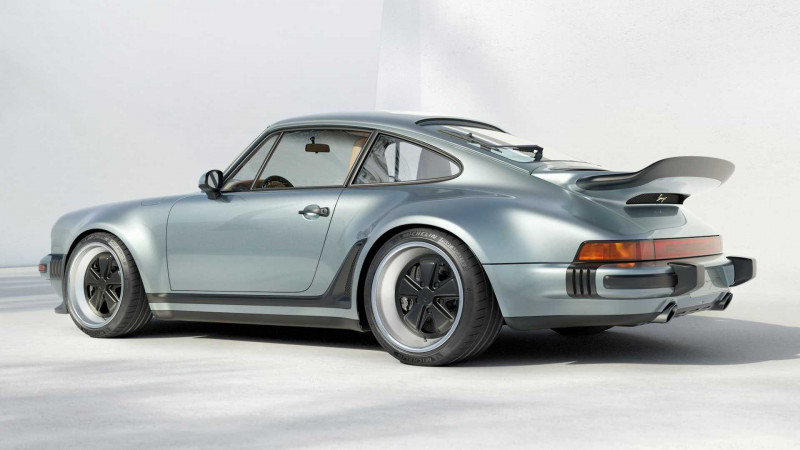
This time, the twin-turbocharged setup borrows BorgWarner blowers with electrically controlled wastegates from today’s 992 Carrera range. However, one thing is missing: the intercooler, particularly the one that perched atop the 930 3.3-litre model. “We wanted to avoid being faced with a big ugly intercooler when you opened the decklid,” says Rob. “You never really got to see a 930 Turbo engine. The intercooler obliterated it, even if it did have a kind of brutish charm.” Singer’s CEO Mazen Fawaz says the intercoolers are “actually in the intake plenum, above the throttle bodies”, explaining the neater look of these air-towater chillers (original 930s used air-to-air cooling). Oil circulating round the engine, meanwhile, is also cooled by a water-to-oil heat exchanger, helping to manage the greater thermal loads of an engine more powerful than the original 260-300bhp 930s. Power outputs are tailored to each customer, but quoted as “starting from” 450bhp. Drive is taken to the rear wheels via a six-speed manual gearbox, although Singer is still debating whether that should be an off-the-shelf Porsche transmission or a bespoke unit. The idea is to create a factory feel, not just chase headlines and 0-60mph times. “Anyone can hot-rod a turbo engine, but does it feel hot-rodded, or does it feel like it was born that way?” asks Mazen rhetorically.
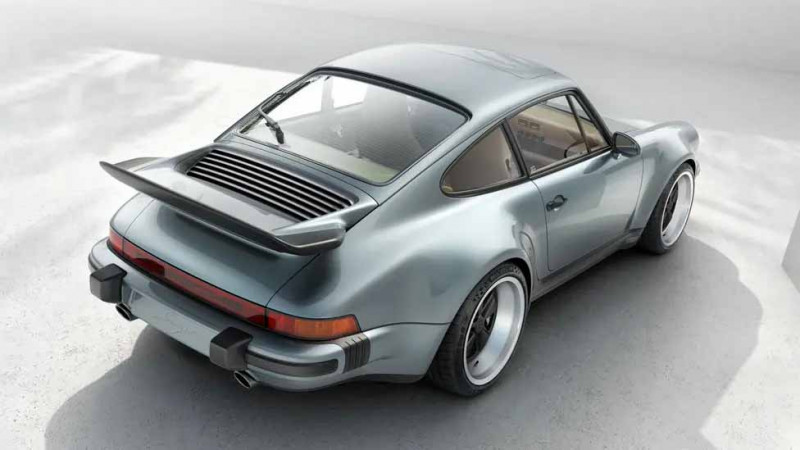
“The boost is relatively low, because the car is meant to be refined, not laggy. We took the turbos from the 992 Carrera because they’re quite compact and a nice, clever package with the catalyst. It’s a two-valve air-cooled lump, but we’ve added things like modern bearings and software to that relatively old system – it’s a very cool combination, and not at all like a modern car.” All-wheel drive is optional, traction control a standard-fit comfort blanket, but for now a six-speed manual transmission is standard – though Mazen admits that PDK is “a discussion” and doesn’t entirely rule it out. The ride height and suspension is tuned for highway cruising – if still with an underlying sporting focus – and Mazen is at pains to point out that while the trailing arm rear suspension does channel road noise into the cabin, the feel of that setup is part of the essence of these pre-1990s 911s. Besides, Singer has worked hard on dialling down NVH (noise, vibration and harshness) with modern bushings, bearings and sound-proofing, while additional adjustability of components and modern damping adds to the plusher refinement. It’s certainly refined when you open the driver’s door, with a feel that again riffs deferentially on the 930 Turbo, including its fluted door cards, the classic five-gauge dash layout, heated and electrically adjustable Sports seats with integrated headrests and figure-hugging bolsters, but again the execution takes the 1970s theme to another level entirely.
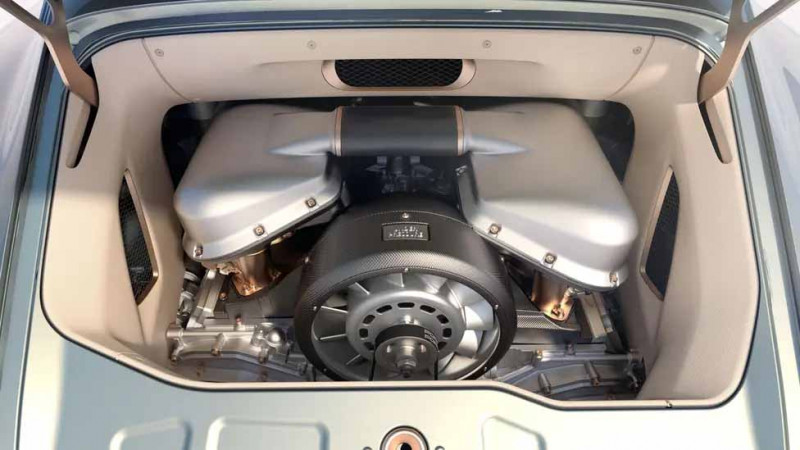
The upholstery is beautiful Malibu sand leather trim with restrained Black Forest wood trim inserts, the retro dials reimagined with a striking modern clarity. Elsewhere, there’s a new twist on the three-spoke steering wheel, large speaker grilles integrated in faithful reimaginings of the original door cards and centre console, and even a wireless smartphone charger that’s positioned just ahead of the gear stick. Rob is delighted with how Singer’s latest endeavour has turned out, particularly because the original tugged so profoundly at his heart strings. “I believe the Turbo Study is a fitting tribute to a car that changed my life, and many others,” he says. It seems the “many others” with the necessary means agree, and Singer reveals that 70 orders have been placed so far for bespoke commissions based around the Turbo Study theme. Most of us can only dream, but we’ll be able to see the Turbo Study up close and in action at the Goodwood Festival of Speed, held on 23-26 June, 2022. No doubt a few 11-year-old kids will never be quite the same again.



